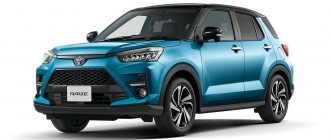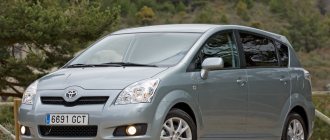When Toyota introduced the RAV4 (all-wheel drive vehicle) in 1994, it essentially invented the compact SUV. And the Japanese auto giant probably didn't realize what a phenomenon this car would become.
More than two decades later, most automakers have a small SUV in their lineup: some, even several. Meanwhile, Toyota is now in the fourth iteration of its RAV4, and the car is more luxurious and spacious than ever. So far it has also proven to be reliable, as you would expect from a manufacturer known for its reliability.
The RAV4 isn't a class leader, but it's still a strong choice in many ways, with a five-year warranty.
Models in review
The Toyota RAV4 first went on sale in 1994 and is now in its fourth generation. We're focusing on the Mk3, which was in production from 2006 to 2012, and the latest Mk4 model in this review.
- * Toyota RAV4 Mk3 (2006-2012) - The long-established SUV is still a great used buy
- * Toyota RAV4 Mk4 (2013 - present) - the latest version of the original compact SUV, highly rated for reliability and quality
Story
The fourth generation RAV4 reached showrooms in March 2013. At the start there was a choice of a 2.0 petrol engine and a 2.2-liter D-4D diesel engine. Buyers had a choice between Active, Icon and Invincible trims, but since January 2015 a business version based on Active has also appeared.
Initially, the 2.0 D-4D was produced only with front-wheel drive, but in January 2014 all-wheel drive appeared. At the same time, the Icon and Invincible received additional kit and additional driver assistance systems.
The December 2015 facelift brought a new 2.0-litre diesel engine, exterior styling and a major interior overhaul, with the Excel trim replacing the Invincible trim. A month later, the RAV4 Hybrid arrived, combining a 2.5-liter gasoline engine with an electric motor.
Transmission
The third generation Toyota RAV4 received a new electronic inter-axle torque distribution system, Active Torque Control 4WD (ATC), which optimally distributes torque between the axles, thereby improving vehicle stability. ATC allows you to redistribute torque between the front and rear wheels in a ratio from 100:0 to 55:45. Although the driver himself can fix the distribution in the proportion 55:45 using the 4WD Lock key on the instrument panel. The VSC system is inherently unique. Together with active steering, it corrects the trajectory of movement, not only by braking any wheel, but also by steering to prevent skidding.
Which one is more profitable to buy?
All petrol models have all-wheel drive and an automatic gearbox, while the 2.2-litre diesel RAV4s have all-wheel drive but have a choice of manual or automatic gearbox. All hybrids are automatic only, while the 2.0 diesel gets a manual transmission but comes with a choice of front-wheel drive or all-wheel drive.
Toyota doesn't skimp on standard equipment: even the entry-level active car comes with 17-inch alloy wheels, Bluetooth, air conditioning, privacy glass and heated mirrors.
The Icon also features a power trunk, 18-inch wheels, a touchscreen infotainment screen, folding door mirrors, cruise control, sport seats and automatic wipers. The Invincible spec adds leather trim, heated front seats, rear parking sensors and keyless entry.
Bottom line
The first impressions after a short trip in the RAV4: an obedient, quite dynamic and completely lightweight modern SUV for lovers of not only active recreation, but also active driving.
Pavel DRUZIN. Photo by Anatoly GORNOSTALEV
up
Japanese
The Toyota car brand comes from the surname of the company’s founder, Toyoda. The history of the company began not with the production of cars, but with the production of... mechanical looms. But in 1933, Toyoda Automatic Loom Works opened an automobile department. As a result, the automobile industry took precedence over the textile industry, and the company began working on cars in earnest. By the way, there are two more versions about the origin of the name Toyota. According to the first, this word, composed of two syllables “toyo” and “ta”, literally means abundance of rice. The second version says that the first syllable “toyo” is translated as harvest, and the second “da” as field, which together makes up the phrase abundant or fruitful field.
As for the name of the RAV4 model, it is an abbreviation of the English phrase, which stands for Recreational Activity Vehicle, 4-wheel drive, and is translated as an entertaining active vehicle with all-wheel drive. Also, the phrase recreational vehicles, loosely translated, can mean something like a recreational vehicle. By the way, the debut of the first version of the RAV4 took place at the Geneva Motor Show in 1994. Soon its mass production began. It is curious that the RAV4 in Japan was called completely differently - Fun Cruiser. The word fun is translated from English as joke, fun, amusement, and also to joke.
But the word cruiser in English means: - cruiser; — comfortable boat; - a person going on a cruise; - an airplane or spaceship (in science fiction); - a police car patrolling the streets.
From French, cruiser is translated as a small yacht, and from Italian – a sports and recreational vessel. So, the name Fun Cruiser can be deciphered in different ways, for example, a comic boat or a funny yacht.
Alina FINC. Based on materials from the Russian press
up
Alternatives to Toyota RAV4 Mk4
The Audi Q3 and Volkswagen Tiguan are on the more expensive end of the spectrum and are very capable, well built and come with excellent engines. In terms of driving pleasure, build quality, standard equipment and good styling, you'll have to go a long way to beat the Mazda CX-5. This car also has excellent reliability records.
The Ford Kuga is also improving rapidly and is decently priced, plus there are plenty of variants to choose from, many of which are top-of-the-line models.
What to look for:
Interior
The cabin is a winner in terms of practicality, as the seats are comfortable and there's plenty of space front and rear. But the dashboard design doesn't match the Toyota's asking price: it looks a little dated and some of the plastics feel disappointingly flimsy. However, boot capacity is 547 liters, or 501 liters for hybrid models.
Tire pressure
Problems with the tire pressure monitoring display usually occur because the system was not adjusted properly after new tires were installed.
Lighting devices
Some condensation may form inside the headlights, but this should disappear very soon after the headlights are turned on.
Extraneous noise and vibrations
Some owners report rattling and vibrations that seem to be caused by a faulty dual mass flywheel, but this is usually just the exhaust pipe or manifold cover.
Spare wheel
A tire repair kit was only offered at launch, but Toyota has changed it to save space following customer feedback, so be sure to check any potential purchase.
Serious and roomy
The RAV4 is often called a woman's car, most likely due to its small size and distinctive appearance. But our guest today is far from small, and he looks quite serious. A modern design combining chopped angular shapes with smooth contours, a purposeful look of headlights, a plastic body kit, four full doors and a rear with a spare wheel give the RAV4 a solid appearance. The toy-ness of previous models has disappeared, but now it’s impossible to call it purely feminine. And the cabin capacity is quite decent - five, even with small luggage, will fit easily.
Operating costs
All RAV4s must be serviced every 12 months or 10,000 miles for private owners. The first inspection will cost 18,000 rubles, and after it the services will alternate between secondary and basic at a price of 33,000 and 39,000 rubles, which is of course a bit expensive (prices of official dealers)
However, when these cars reach five years of age, they are eligible for reduced price servicing, with the servicing cost reduced to RUB 10,000 and RUB 18,000 respectively. Brake fluid should be changed every two years, and coolant should be changed after 160,000 km and then every 80,000 km: both are included in the relevant main maintenance. Luckily there are no cambelts (timing belts) to worry about.
Car reviews
Toyota has an unrivaled reputation for making reliable vehicles, and the current RAV4 proves that. Since this version of the compact SUV arrived in the spring of 2013, several Toyotas have been recalled, but most of them are for vehicles built a decade earlier. A total of nine recalls have been issued across all four generations of the RAV4.
Potential glitches included tire damage and airbag malfunctions, as well as an accelerator pedal problem that affected the Toyota lineup in 2010. But the record of the last car is untarnished.
Story
The RAV4 Mk3 reached dealers in February 2006 in the form of 2.0 VVT-i (petrol) or 2.2 D-4D (diesel). The petrol engine was offered with a five-speed manual or four-speed automatic gearbox, while the diesel was available in 140 (134 hp) or 180 (175 hp) variants, both with a six-speed manual gearbox. The highly specialized XT-R version appeared in January 2008, six months before the introduction of the sporty 2.2 D-4D SR180. Since September 2009, the 2.2 D-4D engine received an optional automatic transmission plus supercharging up to 148 hp. s., while the 2.0 VVT-i was replaced by a more efficient 2.0 Valvematic unit, offered in 4WD CVT or FWD manual form.
The 2010 facelift brought styling changes and trim options were reduced to just XT-R and SR, with extra kit for the former.
Engine
The Toyota RAV4 is equipped with a 2.4-liter gasoline power unit with a VVT-i variable valve timing system, which is equipped with the Camry and Avensis models. This motor has already proven itself to be quite reliable and unpretentious. Before major repairs, it can serve up to half a million kilometers. The gas distribution mechanism is driven by a chain whose service life is more than 300 thousand km. Adjustment of valve clearances may be required only after 200 thousand km.
Iridium spark plugs last 15-25 thousand km; failure to replace them in a timely manner can cause the ignition module to fail. Fuel and air filters must be changed every 15-20 thousand kilometers. It is recommended to wash the injectors every 40 thousand km. After a mileage of 100 thousand km, it is necessary to check the condition of the drive belt.
Which one is more profitable to buy?
Toyota offered this RAV4 as a five-door only, and most buyers opted for the 2.2 diesel. This muscular, fuel-efficient engine provides towing capabilities and good cruising qualities that gasoline units can't match, but it's not as reliable overall. The manual transmission is nicer to use than the V-matic CVT, although the regular automatic (2.0 VVT-i and 2.2 D-CAT) is fine.
All RAV4s get alloy wheels, heated mirrors, air conditioning, power windows and a CD/tuner. The XT4 trim adds a power sunroof, dual-zone climate control, multifunction steering wheel and leather trim, while the XT5 also has satellite navigation, cruise control, automatic headlights and wipers plus heated front seats. The t180 range has a sportier trim with low-profile tires and 18-inch wheels, so it rides firmer than the lesser editions.
Passenger car
The RAV4 accelerates actively, the engine with variable valve timing VVT-i willingly spins up to 6,300 rpm, and the automatic transmission shifts through gears smoothly and quickly. But this is if you press the pedal to the floor. In standard modes, the engine spins up to a maximum of three thousand, providing smooth and measured acceleration - just what you need for city traffic. The RAV4 handles like a regular passenger car, the perfectly tuned chassis allows you to confidently hold the course even at high speed, and it dives into sharp turns easily and without frightening rolls. Smoothness is clearly sacrificed for handling. The profile of the road is transmitted in too much detail to the body. This can only be combated with the help of the accelerator pedal: either, lightly pressing it, drive slowly, enjoying the silence and comfort, or add a lot of gas - at high speed, the rigid suspension reliably keeps the body from swaying, without noticing small potholes and asphalt joints.
There are no complaints about the brakes - the informative pedal allows you to accurately control the deceleration. The powerful hydraulic booster makes the steering wheel very light - you can turn it on the spot with one finger, and you don’t have to strain too much while moving. The sound insulation of the cabin is at a fairly good level: the engine can only be heard during rapid acceleration, the work of the suspension is transmitted to the cabin only on serious bumps, and there are no plastic squeaks yet.
Alternatives to Toyota RAV4 Mk3
The Qashqai has been an incredible success for Nissan thanks to its reliability, ease of driving and ease of use. If you want something more, just look at the Nissan X-Trail. Other SUVs you may want to consider include the Honda CR-V. The Ford Kuga is more fun to drive and a valuable used purchase.
The VW Tiguan is efficient and very capable. Plus, the often overlooked Volvo XC60 is worth a look, as it's safe, stylish and well-equipped. Finally, don't forget the Land Rover Freelander 2. Although it doesn't have the best reliability ratings, it offers a strong image and excels off-road.
Preface
As a rule, owners do not want to get rid of a RAV4 until it causes trouble, and during normal operation, unscheduled service visits are practically excluded. But the place in the sun on trading floors is occupied by “killed” cars - emergency or completely worn-out “rafiks”. Therefore, diagnostics before purchase is not only desirable - it is extremely necessary!
There are a lot of Rafiks from the USA and Canada on the market. Although cars with an American pedigree are cheaper, there is a lot of outright junk among them. Out of ten copies there will be a maximum of three worthy ones. But for this reason alone, you shouldn’t immediately give up on the Yankees. The advice here is still the same - a thorough examination and diagnosis.
What to look for:
Steering
Steering clunking suggests a worn countershaft. However, it could also be a slightly loose wheel nut.
Cylinder head gaskets
Head gaskets can fail on a diesel engine, so check for misfires with signs of a white emulsion on the underside of the oil filler cap.
Oil consumption
Oil consumption can be very high before Toyota says there is a problem with the engine - up to one liter every 1600 km is acceptable.
Headlights
Many owners are unimpressed with the standard headlights.
Interior
There's plenty of room for four (five if kids are in the back) and the front seats are supportive and highly adjustable. The steering column also adjusts to the driver, and the rear seats fold flat to create an even cargo area. The boot capacity is 586 liters with the seats up or 1,469 liters when folded.
Cream leather and hard plastic
The interior is ultra-modern to match the appearance: the combination of cream leather with dark gray plastic and aluminum inserts looks quite nice and interesting, especially the two-story front panel. The only disappointment was the quality of the plastic: although it seems soft and noble, it is actually hard, and if you knock on it, it is also loud.
Using the equipment located on the steps of the center console is easy and convenient. At the top is the audio system, below is the climate control unit with separate temperature controls for the driver and passenger. To the right of the steering wheel is a center clutch lock button; at the very bottom, near the automatic transmission lever, there are a pair of cup holders, a niche for small items and seat heating buttons. Between the seats there is a box armrest and mirror adjustment keys. The front passenger has two glove compartments at his disposal: the lower one is a standard one with a hinged lid, the upper one is a small shelf closed by a sliding panel.
The optitronic instrument panel has three wells, in the central one there is a speedometer and on-board computer display, in the left there is a tachometer, in the right there are temperature and fuel level indicators. White numerals and ruby hands are clearly visible in any lighting. Like any crossover, the RAV4 is taller than a regular sedan, but there are no problems with landing - low thresholds provide unobstructed access to the cabin. The front seats are comfortable, with good lateral support; the driver's seat, by the way, is adjustable using servos, but the passenger will have to work with levers. The steering column also has adjustments for reach and tilt. On the left spoke of the steering wheel there are audio control buttons, so you can control the music with just the left. The rear seats are equipped with adjustments for the length and angle of the backrests. By moving the seat forward, you can increase the trunk volume, and if you fold down the armrest, you can transport long items, such as skis.
Operating costs
All RAV4s require some maintenance every 12 months or 10,000 miles, with services typically alternating between minor and major. However, there is also a major MOT+ every four, six or eight years, depending on the specification. Minor maintenance will cost 14,000 rubles, major – 23,000 rubles and major maintenance + – 29,000 rubles, dealers can charge less if they want.
Since all RAV4 engines have a timing chain drive, there is no need to replace them. However, the brake fluid must be renewed every two years at a cost of 3,000 rubles, and the air conditioner must be serviced every year at a cost of 1,500 rubles: it is recommended to completely refill the air conditioner every two years at a cost of 6,000 rubles. New coolant is required every 10 years at a cost of 8,000 rubles.
Car reviews
There have been four recalls of the Mk3, the first in February 2010. Cars from February 2009 to January 2010 could suffer from the fact that the gas pedal did not return to idle: however, there were no accidents. Some RAV4s had a faulty rear suspension arm before August 2010; Toyota recalled them in September 2012. A window switch short circuit between September 2006 and December 2008 led to a recall in October 2012. The most recent campaign occurred in April 2014: some RAV4s made before November 2008 had faulty airbags.









